This is Chapter XVII of G. A. Sekon's History of the Great Western Railway. It has been formatted for our website, with the addition of headings (apart from the one for the Wye Valley, which was already there), links and illustrations, by Jacqueline Banerjee. Full details of the book and the sources of the illustrations, are given in the bibliography at the end. Click on all the images to enlarge them.
Early Proposals

N 1844, the Great Western Railway revived the proposition of constructing a railway from Stonehouse, across the Severn, along its western bank, through Chepstow, Newport, Cardiff, Swansea and Carmarthen, with a branch right and left, one to Milford Haven and the other to Fishguard, from whence a service of steamers were to run to Waterford. The following were the lines proposed to be constructed:—

It was proposed to cross the Severn by a bridge 2000 feet long at a horseshoe bend, and to cut a ship canal across the bend for the passage of large ships; the railway would cross this canal by a swing bridge, so that no inconvenience would result to the navigation tion of the river. There would be a tunnel near Swansea 1320 yards long, and another near Kidwelly 1463 yards in length. The total cost of construction was estimated at £2,800,000, and the 250 miles between [234-35] London and Fishguard was expected to be covered in 5 hours.
The time taken to-day (fifty years later) to perform this journey from London to New Milford, 272½ miles, over exactly the same course with the substitution of the Narrow Gauge is 7 hours 10 minutes, while other trains take as long as 10 hours 40 minutes to cover the distance. The Committee of the House of Commons declared the preamble of the Bill proved, but the Admiralty having decided against the bridge across the Severn, the Chairman said they had come to the following decision:— "That, although the preamble of the Bill is proved, the success of the whole scheme of the South Wales Railway so entirely depends upon that part of the work to which the Admiralty object, that they cannot consent to proceed in the investigation of a measure which the promoters have not the power of accomplishing."The whole House then discussed the Bill, and referred it back to the Committee. The Opposition urged that as it was not now proposed to make a railway according to the preamble, the Bill did not comply with the standing orders, and, therefore, could not be proceeded with. The preamble was allowed to be altered, to allow of a line being constructed from Chepstow to Pembroke, and this received the royal assent 4th August 1845. In their Bill the next year the South Wales Railway proposed alternative modes of crossing the Severn, but neither of these methods was sanctioned, the Admiralty being in favour of a bridge and the House of Commons of a tunnel, so that the South Wales Railway had to avail itself of a clause in another of their Bills and construct a railway along the Welsh side of the Severn to Gloucester. This made the distance to London considerably longer, and, therefore, another line was projected from Gloucester to Cheltenham, and thence through Chipping Norton to Oxford. [235/36]
Construction
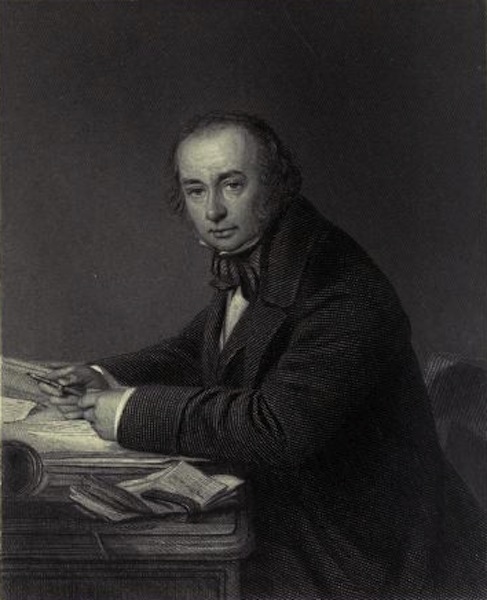
Portrait of Isambard Kingdom Brunel (frontispiece to Brunel).
In 1846, the Great Western Railway agreed to lease the South Wales Railway in perpetuity, as the various sections were completed. The construction of the line was immediately proceeded with, and the boring of the Hillfield Tunnel caused the good folks of Newport considerable inconvenience. This tunnel is 200 feet below the surface, and lower than all the wells supplying the town, so that all the wells ran dry, and the inhabitants had to obtain a supply of water from elsewhere at a large expense, so they did not think the South Wales Railway an unmixed blessing. Mr Brunel was at this time constructing many timber viaducts on the lines of which he was engineer, and he did not neglect the South Wales Railway in this particular, the principal one being that at Landore, over a mile long and 160 feet high. The original bridge across the Usk was a wooden one 1200 feet long, the centre span being 99 feet and the other 70 feet wide.
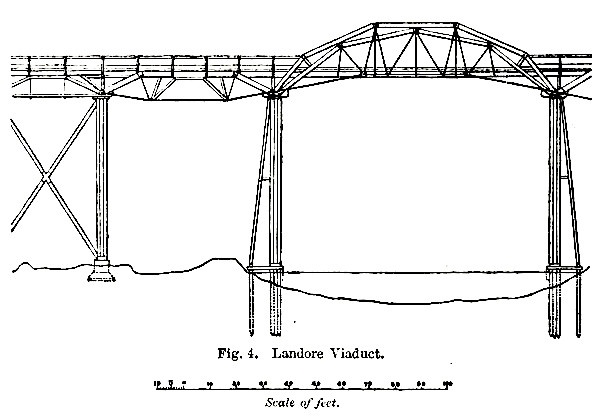
The Landore Viaduct (Brunel 184).
When this bridge was almost completed, it was, unfortunately, burnt down, and gave a vivid illustration of the saw that "great events from little actions spring." On 31st May 1848, at 6 P.M. the workmen engaged in completing the central arch, which was on an immense pile, consisting of several tons weight of timber and iron bolts, were busy at work driving in the bolts, when one man used a bolt which had been heated to an extraordinary degree. This immediately ignited the adjoining timber, which, being highly kyanized or "pickled," was as ignitible as gunpowder. The man had a bucket of water at hand, as was always usual, but it was useless, for the flames leaped along on each side from the centre to each end of the bridge, and the whole extent was instantly in a terrible blaze. The men with difficulty escaped with their lives. A team of trams was passing at the time, and the horses, put to their utmost gallop, were obliged to dash through the flames to escape. The whole town rushed to the great stone bridge adjacent, and hundreds [236/37] of navvies, carpenters, masons, labourers, tradesmen and gentlemen were quickly on the spot, but it was of no avail. The town fire-engines were brought, but acted with no effect on the awful flames bursting from the surface of the piles, the rails, the arches, and in fact wherever the fire could lay hold of wood to burn. The timber work was so enormous that it took a considerable time to burn any portion wholly away, while the patent composition used to preserve the wood lent assistance to the flames, which rose up with blue and black smoke, filling all the heavens. At about 9 P.M. the ponderous work of the central arch gave way with a terrible crash, and soon after this; portion after portion fell, until, with the exception of here and there a solitary black and charred fragment, with some portion on the banks, the whole of this magnificent work was totally destroyed. The river was black with burning wood, and the banks became strewed with enormous pieces of half-burnt wood like the coast after a wreck. The fire-engine from the barracks did great execution, worked by two companies of soldiers under the command of officers, and the town engines did all they could, but it was a physical impossibility to save even a fragment; we might as well suppose a portion of a barrel of gunpowder could be found after the ignition of the barrel. The bridge was almost completed when this unfortunate calamity occurred. It had been built of kyanized timber by the eminent contractors Messrs Rennie, Logan and Company, and cost upwards of £20,000 in the erection. Fortunately for the contractors, the terms of their contract with the railway company necessitated them insuring the timber bridges during construction, so that the Fire Insurance Company bore the loss.
Near Llansamlet, between Neath and Swansea, Mr Brunel introduced a novel method to prevent the earth, which forms the side of the deep cutting, from slipping. The usual procedure is to build retaining walls, but, as these must be very massive and solidly [237/38] built, to save expense, Mr Brunel designed four flying arches over the cutting. The thrust of both sides of this cutting would be concentrated on the arch of these bridges, so that they were likely to be forced up at the crown and so destroyed. To prevent such a contretemps, Mr Brunel weighted the centres of the arches with masses of heavy copper slag, and by this means the thrust of the arches on the sides of the cutting balanced the thrust of the cutting on the crown of the arch, and the purpose in view, viz., the non-erection of expensive retaining walls, was successfully accomplished.
Wye [i.e. Chepstow] Bridge

The Chepstow Bridge (Illustrated London News, 24 July 1852; click on the picture for more details).
The chef d'oeuvre of the South Wales Railway is the Chepstow Bridge over the Wye, which Mr Williams, in his interesting work, Our Iron Roads, thus describes:
A tubular bridge has been constructed over the Wye at Chepstow, on the South Wales Railway, to which allusion must be made. It consists of four spans, three of about 100 feet each, and one of 290 feet, extending altogether from bank to bank for 610 feet.
The chief span is a modification of the suspension principle, the great length of the girders requiring more support than that afforded by the piers alone at each extremity. Mr Brunel accordingly contrived that this should be given by means of a tube 309 feet in length and 9 in diameter, which, having been raised to the summit of piers erected on the east bank and in the centre of the river, is strengthened by massive chains secured to the girders. These girders are 50 feet above high water mark at spring tides, which here rise from 50 to 6o feet, being more than any other river in the kingdom.
In sinking the cylinders to form the piers of the [238/39] bridge, the workmen had first to pass through 29 feet of blue clay and sand, below which they met with a thin bed of peat containing timber, some solid oak, hazel-nuts, and other similar substances. They next came to several feet of fine blue gravel, and then they reached a bed of boulders, upon which the cylinders were originally intended to rest. After this was a bed of red marl, beneath which was solid rock like millstone grit, and into this the cylinders were sunk. The mode in which this part of the work was performed was curious. The cylinders were placed on planks to prevent their cutting into the soft mud. One by one cylinders were added until they had reached the top of the stage (about 100 feet in height) which had been erected for the purpose of sinking them. The weight of the column now cut through the planks, and the cylinder sank about 6 feet into the mud. Two or three men then descended into it, and, as they removed the contents, the cylinder continued to sink, and as it descended fresh cylinders were added at the top. This process continued without interruption till a depth of about 17 feet was attained, and then a spring was tapped, and without a moment's notice the water broke in from below in such force as to require the constant action of two 13-inch pumps worked by an engine. A remarkable fact attending this occurence was, that the spring water invariably rose in the cylinder exactly at that height to which the tube was standing in the river at the moment. That it was not an interruption from the Wye was considered to be beyond dispute, inasmuch as the river at this point, from the action of the tide, was always heavily tainted with mud, while the water which rushed into the cylinder from below was of exceeding purity, and did not contain a particle of salt.
The first locomotive engine on the South Wales Railway, named the "Dove," and a tender were hauled from Gloucester on a carriage built purposely, and drawn by eighteen fine grey horses. Four superior [239/40] black horses hauled the tender. The novelty of the load and the beauty of the teams drew the attention of a number of people. In August 1849, a committee of shareholders was appointed, who recommended the abandonment of the line from Whitland to Fishguard, and, consequently, this portion of the line was not constructed, so that the Irish connection is via Milford. The Great Western Railway leased the South Wales Railway as soon as the various sections were opened. At first a rent of £46,000 per annum for the whole line was paid, together with two-thirds of net profit the Great Western Railway providing rolling stock. This arrangement did not, however, work well, and in 1861 a rather serious quarrel arose between the two companies, because the Great Western Railway contended that the Barlow saddle rail was not suitable for the traffic, and they renewed it with their ordinary pattern rail, charging the expenses to renewal of permanent way, and so reducing the net profit considerably. The two railways thereupon went to arbitration, and a new arrangement was entered into, which finally resulted in the Great Western Railway absorbing the South Wales Railway into its own system.
The route to South Wales via Gloucester was from the very first constructed as one necessary from the force of circumstances, or in other words it was felt that the direct route should branch from the Great Western system in the neighbourhood of Bristol, but the river Severn debarred the physical continuation of such a direct line. The Bristol and South Wales Union Railway was therefore formed in 1846, to construct a line, 14½ miles long, from Bristol to New Passage, thence a steam ferry across the Severn to Portskewett, which joined the South Wales Railway by a short branch. This shortened route was not opened until 1863, and although the distance between London and Newport and stations below on the South Wales Railway was thereby shortened by some miles, the route, save for the local traffic between Bristol and [240/41] South Wales, was never popular in consequence of the ferry. Brunel is incorrectly reported to have proposed ferrying the first-class railway carriages across to save the passengers the trouble of changing to and from the steamers. The mistake arose through an error of a newspaper reporter, who, in giving an account of a meeting of shareholders of the Bristol and South Wales Union Railway, held at Bristol on 9th March 1847, attributed such a statement to Mr Brunel, when, as a fact, he was not present at the meeting at all.
The observation as to the railway carriages crossing the river was made by one of the Directors, who said "He believed that Mr Brunel expected to be able," etc. The reporter failed to note that it was a Director speaking, which, together with the omission of the three words, "he believed that," caused the mistake and led to rather an awkward contretemps a few months later, when Mr Brunel was under cross-examination before a Parliamentary Committee.
The Severn Tunnel
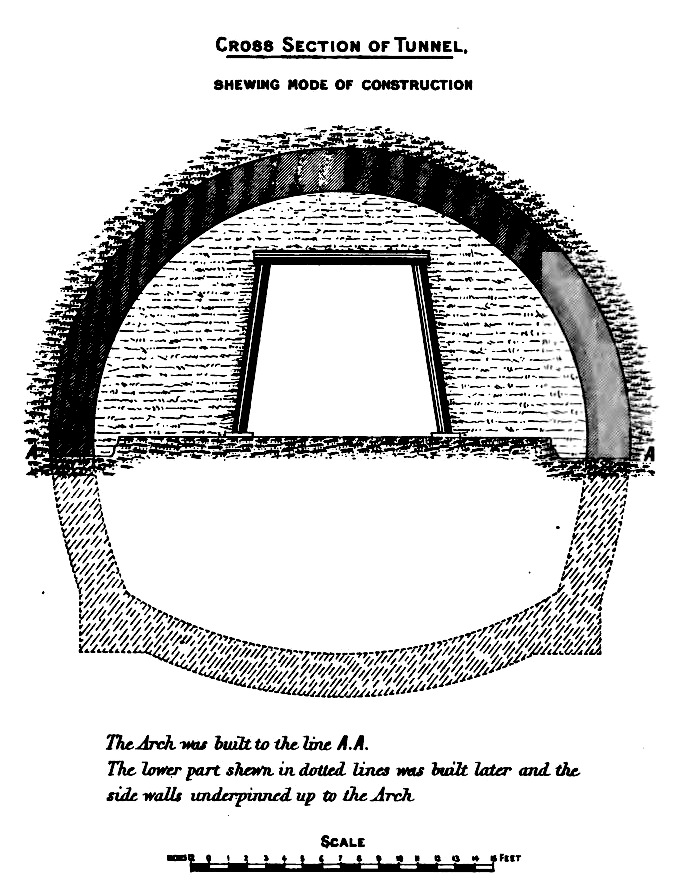
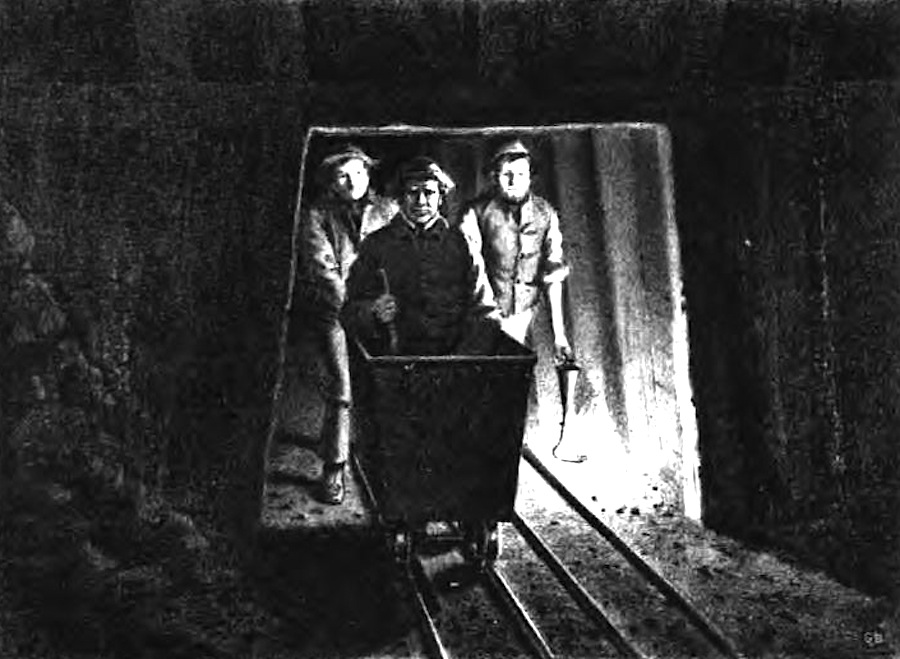
Left: Cross-section of Severn tunnel (Walker, facing p.34). Right: Sir John Hawkshaw inspecting the tunnel (Walker, facing p. 102; working with John Wolfe Barry, Hawkshaw designed and built Tower Bridge, and the railway bridges and stations at Charing Cross, Blackfriars and Cannon Street for the Southern Railway).
The Great Western Railway took over this short connecting line and ferry in 1868, after which the proposals for a Severn Tunnel assumed a practical shape. Much has been written on this gigantic engineering undertaking — a gigantic one even for the Great Western Railway, with its wealth of colossal engineering achievements. The history of the venture is truly romantic, and has been delightfully told by the late Mr Walker, the contractor, in his book.
This is the most modern engineering triumph in the history of the Great Western Railway, and at present no other great works in connection with the Great Western Railway are contemplated, nor indeed are any such (so far as can be judged) likely again to occur on its system. If long lines of figures can convey even an approximate idea of the colossal nature of the engineering feat accomplished by the triumphant construction of this subaqueous tunnel, we will, before giving an outline of the trials and difficulties which [241/42] were so successfully overcome in the construction of the Severn Tunnel, present to our readers' notice the following:— 3100 men employed in its construction, 76,400,000 bricks used to line it, 36,794 tons of Portland cement used in setting the bricks, 250 tons of explosives used to blast the rock, 30,000,000 gallons of water pumped per day, and 23,000,000 gallons of water the average quantity pumped daily during construction.
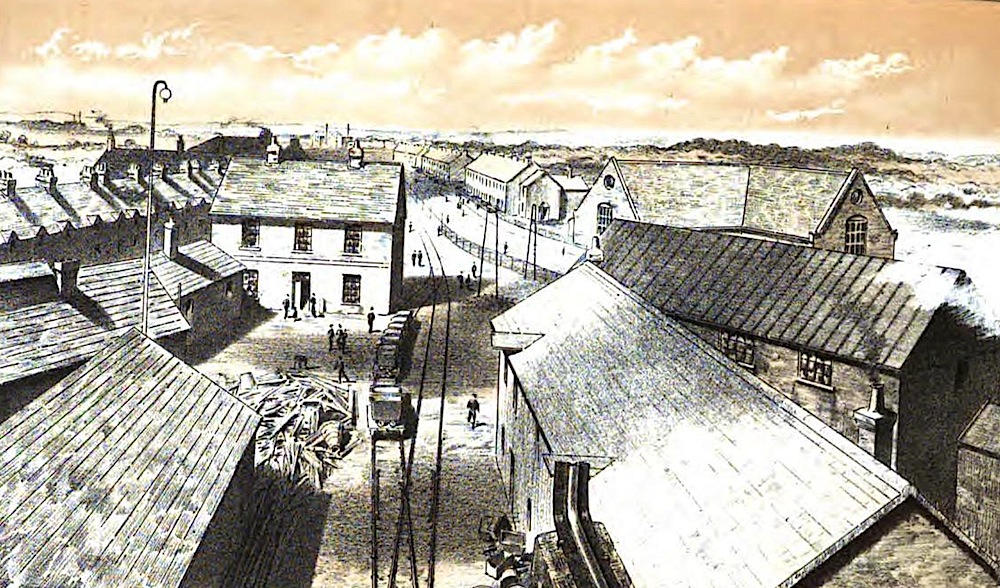
The works, Sudbrook (Walker, facing p. 218).
The tunnel beneath the Severn was not the first proposal of the Great Western Railway as a means of obtaining a shorter route to South Wales, the original idea being a bridge at Chepstow, an Act for which was duly obtained. The plans for the tunnel were adopted in 1871, and next year an Act of Parliament authorising its construction was obtained, and the necessary works were commenced in 1873. At this time there was not a single house at Sudbrook — the headquarters of the Tunnel Works — but when operations were commenced a small office and six cottages were erected, and a temporary line laid down to Portskewett Station. Little progress was made in the construction of the tunnel, and in 1877 the Great Western Railway advertised for tenders. Only three firms tendered, and as the Directors considered them all too high, they determined to proceed with the tunnel themselves; but the progress was still very slow, for by 18th October 1879 only 130 yards of a tunnel 7 feet in diameter had been constructed on the Welsh side, when an underground spring of water was unexpectedly tapped, and the whole works were completely flooded. This accident caused another change in the Directors' plans, and they now determined to accept, with slight modifications, the tender of Mr T. A. Walker, one of the three previously mentioned. Mr Walker commenced operations on i8th December 1879. The specification stated that the tunnel was to be 7942 yards in length, and the railway through the tunnel and the connecting lines 7 miles 5 furlongs [242/43] long. It was to be lined throughout with brickwork, 2 feet 3 inches thick, with a brick invert for half the way through the tunnel. The permanent way was to be sleepered, and the rails to weigh 86 Ibs. per yard. Afterwards it was decided to increase the brick lining to 3 feet in thickness, and to have an invert the whole length of the tunnel, to lay it with the famed longitudinal sleepers and Great Western bridge rails, 68 Ibs. to the yard. The lowest level of the tunnel in the centre of the river was also increased by 15 feet, and the line fell from the Welsh side by a continuing gradient of 1 in 100, and on the English side 1 in 90. A considerable part of the roof of the tunnel had already been bricked in before the decision to alter the level was arrived at, and Mr Walker adopted a novel and successful plan to utilise the brickwork already executed. This he supported, and then built under it continuing side walls down to the new level, and the invert under this.
The colossal new pump provided to drain the tunnel burst on 2nd July 1880, and the works were again completely flooded. The Great Western Railway provided another new pump of immense power, which was got to work on 12th October 1880. But, despite the millions of gallons of water pumped from the tunnel daily, the workings could not be emptied of water, so a diver was sent to shut a sluice door in the middle of the tunnel, his instructions being to turn the screw governing the sluice a certain number of times one way. After several exciting attempts he reached the sluice and carried out his instructions, but to the surprise of everyone this made no difference in the amount of water to be dealt with. Some time after, when the water had been lowered sufficiently to allow of the sluice being visited, the door was found wide open, but the mystery was explained. It was found that the screw controlling the door was a left-handed one instead of a right-handed one, as it was believed to be, so that when Lambert, the diver, [243/44] turned the screw the number of times as directed, he really opened the sluice wider instead of shutting it, as he would have done had it been a right-handed screw. Upon another occasion this intrepid diver, when in the water, was drawn by the power of the pump against the wind box of the suction pipe, and it required the united efforts of three men to haul him out of this dangerous position.
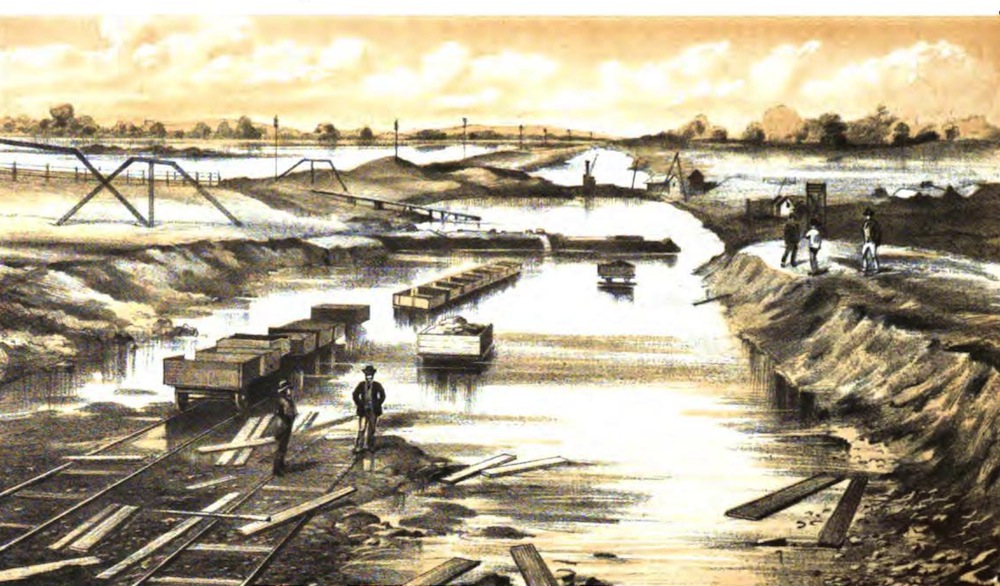
Cutting flooded after high tide, Oct. 17th 1883 (Walker, facing p. 134).
The work was further delayed by a strike of the men in May 1881, but this was of short duration, and for some time the work progressed in a satisfactory manner until the junction of the two headings was successfully accomplished at 10 o'clock on the night of 26th September 1883. Everything now seemed to point to a speedy conclusion of the great undertaking, when, on loth October 1883, the spring again broke out and flooded the whole tunnel. Efforts were immediately taken to obtain the mastery of the water, and with success, but the liquid element was hard to conquer, for when the subterranean spring had thus been finally vanquished, on the 17th October 1883, an immense tidal wave swept the Severn, broke down the river wall built to protect the land from the effect of these waves, which are the highest in Europe, for as far up the Severn as its junction with the Wye the normal rise of the tide is 50 feet.
Such an inundation was totally unexpected, the water rushed down the shaft and imprisoned the men, who retreated before it to the highest point in the tunnel, and their lives were saved by the natural law, which prevented the water rising further in consequence of the resistance of the air which had been driven by the inrush of the water to this spot, and as it had no outlet it resisted the advance of the water, and the men were consequently saved from a watery grave.
This was the last of the series of untoward events that retarded the completion of this mammoth work, and by the 5th of September 1885 the tunnel was far [244/45] enough advanced to allow of a special train, conveying the late Sir D. Gooch, to pass through from England to Wales, 50 feet under the bed of the river, and 145 feet below the level of high water spring tides.
Opening of the Line
The line was opened for goods traffic on 1st September 1886, and for passenger trains on 1st December of the same year, while the regular service of passenger trains between London and South Wales via the Severn Tunnel was inaugurated 1st July 1889. Such is the history of this remarkable triumph of subaqueous tunnelling.
Bibliography
[Illustration source] Brunel, Isambard. The Life of Isambard Kingdom Brunel, Civil Engineer. London: Longmans, Green, 1870. Internet Archive. Contributed by Gerstein, University of Toronto. Web. 14 July 2017.
Sekon, G. A. A History of the Great Western Railway: Being the Story of the Broad Gauge. 2nd ed. London: Digby, Long & Co., 1895. Internet Archive. Contributed by University of California Libraries. (See Ch. XVII on the South Wales railway.) Web. 14 July 2017.
[Illustration source] Walker, Thomas Andrew. The Severn Tunnel: Its Construction and Difficulties, 1872-1887. London: Richard Bentley & Son, 1888. Internet Archive. Contributed from the University of California Collections. Web. 14 July 2017.
Created 13 July 2017